13. Reporting Adjustments on Form 941
There are two types of adjustments: current period adjustments and prior period adjustments to correct errors. See the instructions for Forms 941
and 941c for more information on how to report these adjustments.
Current Period Adjustments
In certain cases, amounts reported as social security and Medicare taxes on lines 6b, 6d, and 7b of Form 941 must be adjusted to arrive at your
correct tax liability (e.g., excluding amounts withheld by a third-party payer or amounts you were not required to withhold). Current period
adjustments are reported on line 9 of Form 941 and include the following:
Adjustment of tax on tips.
If, by the 10th of the month after the month you received an employee's report on tips, you do not have enough employee funds available to withhold
the employee's share of social security and Medicare taxes, you no longer have to collect it. Report the entire amount of these tips on lines 6c
(social security tips) and 7a (Medicare wages and tips). Include as an adjustment in the Other space on line 9 the total uncollected employee
share of the social security and Medicare taxes.
Adjustment of tax on group-term life insurance premiums paid for former employees.
The employee share of social security and Medicare taxes on group-term life insurance over $50,000 for a former employee is paid by the
former employee with his or her tax return and is not collected by the employer. However, include all social security and Medicare taxes for such
coverage on lines 6b and 7b (social security and Medicare taxes), and back out the amount of the employee share of these taxes as an adjustment in the
Other space on line 9. See Pub. 15-A for more information on group-term life insurance.
Note:
For the above adjustments, provide a brief supporting statement explaining the nature and amount of the adjustments (see the example of
reporting current period adjustments below). Do not use Form 941c as the supporting statement for current period adjustments.
Adjustment of tax on third-party sick pay.
Report both the employer and employee shares of social security and Medicare taxes for sick pay on lines 6b and 7b of Form 941. Deduct on line 9
the social security and Medicare taxes withheld on sick pay by a third-party payer. Also enter the sick pay tax adjustment in the Sick Pay
adjustment entry space. No additional statement for this adjustment is required. See section 7 of Pub. 15-B for more information.
Fractions of cents adjustment.
If there is a small difference between net taxes (line 13) and total deposits (line 14), it may have been caused, all or in part, by rounding to
the nearest cent each time you computed payroll. This rounding occurs when you figure the amount of social security and Medicare tax to be withheld
from each employee's wages. If you pay your taxes with Form 941 instead of making deposits because your total taxes for the quarter are less than
$2,500, you also may report a fractions-of-cents adjustment.
To determine if you have a fractions-of-cents adjustment, multiply the total wages and tips for the quarter subject to:
- Social security tax (reported on lines 6a and 6c) by 6.2% (.062).
- Medicare tax (reported on line 7a) by 1.45% (.0145).
Compare these amounts (the employee share of social security and Medicare taxes) with the total social security and Medicare taxes actually
withheld from employees for the quarter (from your payroll records). The difference, positive or negative, is your fractions-of-cents adjustment. If
the actual amount withheld is less, report a negative adjustment in parentheses in the entry space for
Fractions of cents. If the actual amount
is more, report a positive adjustment. No supporting statement is required for this adjustment.

Current Period Adjustment Example
Example of reporting current period adjustments.
Cedar Inc. was entitled to the following current period adjustments:
- Third-party sick pay. Cedar Inc. included taxes of $2,000 for sick pay on lines 6b and 7b for social security and Medicare taxes.
However, the third-party payer of the sick pay withheld and paid the employee share ($1,000) of these taxes. Cedar Inc. is entitled to a $1,000 sick
pay adjustment (negative).
- Fractions of cents. Cedar Inc. determined that the amounts withheld and deposited for social security and Medicare taxes during
the quarter were a net $1.44 more than the employee share of the amount figured on lines 6b, 6d, and 7b (social security and Medicare taxes). This
difference was caused by adding or dropping fractions of cents when figuring social security and Medicare taxes for each wage payment. It must report
a positive $1.44 fractions-of-cents adjustment.
- Life insurance premiums. Cedar Inc. paid group-term life insurance premiums for policies in excess of $50,000 for former
employees. The former employees must pay the employee share of the social security and Medicare taxes ($200) on the policies. However, Cedar Inc. must
include the employee share of these taxes with the social security and Medicare taxes reported on lines 6b and 7b of Form 941. It is entitled to a
negative $200 adjustment.
Cedar Inc. reported these adjustments on line 9 of Form 941 as shown in the
Current Period Adjustment Example

Current Period Adjustment Example on page 24. A brief supporting
statement was filed with Form 941 explaining the life insurance adjustment.
Prior Period Adjustments
Generally, you can correct errors on prior quarter Forms 941 by making an adjustment on the Form 941 for the quarter during which the error was
discovered. For example, if you made an error in reporting social security tax on your second quarter 2001 Form 941 and discovered the error during
January 2002, correct the error by making an adjustment on your first quarter 2002 Form 941.
The adjustment increases or decreases your tax liability for the quarter in which it is reported (the quarter the error is discovered) and is
interest free. The net adjustments reported on Form 941 may include any number of corrections for one or more previous quarters, including both
overpayments and underpayments.
You are required to provide background information and certifications supporting prior quarter adjustments. File with Form 941 a Form 941c,
Supporting Statement To Correct Information, or attach a statement that shows:
- What the error was.
- Quarter in which the error was made.
- The amount of the error for each quarter.
- Date on which you found the error.
- That you repaid the employee tax or received from each affected employee a written consent to this refund or credit, if the entry corrects
an overcollection.
- If the entry corrects social security and Medicare taxes overcollected in an earlier year, that you received from the employee a written
statement that he or she will not claim a refund or credit for the amount.
Do not file Form 941c or the equivalent supporting statement separately. The IRS will not be able to process your adjustments on
Form 941 without this supporting information. See the instructions for Form 941c for more information.
Income tax withholding adjustments.
Correct prior quarter income tax withholding errors by making an adjustment on line 4 of Form 941 for the quarter during which you discovered the
error.
Note:
You may make an adjustment to correct income tax withholding errors only for quarters during the same calendar year.
This is because the employee uses the amount shown on Form W-2 as a credit when filing the income tax return (Form 1040, etc.).
You cannot adjust amounts reported as income tax withheld in a prior calendar year unless it is to correct an administrative error. An
administrative error occurs if the amount you entered on Form 941 is not the amount you actually withheld. For example, if the total income tax
actually withheld was incorrectly reported on Form 941 due to a mathematical or transposition error, this would be an administrative error. The
administrative error adjustment corrects the amount reported on Form 941 to agree with the amount actually withheld from employees.
Social security and Medicare tax adjustments.
Correct prior quarter social security and Medicare tax errors by making an adjustment on line 9 of Form 941 for the quarter during which you
discovered the error. You may report adjustments on the current quarter Form 941 for previous quarters in the current and prior years.
Reporting prior quarter adjustments on the record of Federal tax liability.
Adjustments to correct errors in prior quarters must be taken into account on either Form 941, line 17, Monthly Summary of Federal Tax Liability,
or on Schedule B (Form 941), Employer's Record of Federal Tax Liability.
If the adjustment corrects an underreported liability in a prior quarter, report the adjustment on the entry space corresponding to the
date the error was discovered. If the adjustment corrects an overreported liability, use the adjustment amount as a credit to offset
subsequent liabilities until it is used up.
Example of reporting prior period adjustments:
Elm Co., a monthly schedule depositor, discovered on January 9, 2002, that it overreported social security tax on a prior quarter return by $5,000.
Its total tax liabilities for the first quarter of 2002 were: January - $4,500, February - $4,500, and March - $4,500. Elm Co. completed
line 17 of Form 941 as shown in the Prior Period Adjustment Example on page 26.
Prior Period Adjustment Example
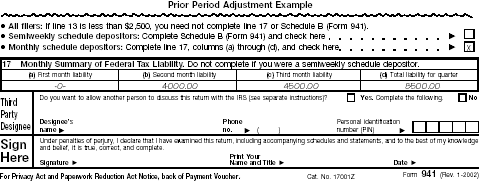
The adjustment for the $5,000 overreported liability offset the January liability, so the $4,500 liability was not deposited and a -0- liability
was reported on line 17, column (a). The remaining $500 of the $5,000 adjustment credit was used to partially offset the liability for February, so
only $4,000 of the $4,500 liability was deposited and reported on line 17, column (b).
Note:
Do not make any changes to the record of Federal tax liability for current quarter adjustments. The amounts reported on the record reflect the
actual amounts you withheld from employees' wages for social security and Medicare taxes. Because the current quarter
adjustments make the amounts reported on lines 6b, 6d, and 7b of Form 941 equal the actual amounts you withheld (the amounts reported on the record),
no additional changes to the record of Federal tax liability are necessary for these adjustments.
Filing a claim for overreported prior period liabilities.
If you discover an error on a prior quarter return resulting in a tax overpayment, you may file Form 843, Claim for Refund and Request
for Abatement, for a refund. This form also can be used to request an abatement of an overassessment of employment taxes, interest, and/or penalties.
You must file Form 941c, or an equivalent statement, with Form 843. See the separate Instructions for Form 843.
Collecting underwithheld taxes from employees.
If you withheld no income, social security, or Medicare taxes or less than the right amount from an employee's wages, you can make it up from later
pay to that employee. But you are the one who owes the underpayment. Reimbursement is a matter for settlement between you and the employee.
Underwithheld income tax must be recovered from the employee on or before the last day of the calendar year. There are special rules for
tax on tips (see section 6) and fringe benefits (see section 5).
Refunding amounts incorrectly withheld from employees.
If you withheld more than the right amount of income, social security, or Medicare taxes from wages paid, give the employee the excess. Any excess
income tax withholding must be reimbursed to the employee prior to the end of the calendar year. Keep in your records the employee's written receipt
showing the date and amount of the repayment. If you do not have a receipt, you must report and pay each excess amount when you file Form 941 for the
quarter in which you withheld too much tax.
Correcting filed Forms W-2 and W-3.
When adjustments are made to correct social security and Medicare taxes because of a change in the wage totals reported for a previous year, you
also may need to file Form W-2c, Corrected Wage and Tax Statement, and Form W-3c, Transmittal of Corrected Wage and Tax
Statements.
Wage Repayments
If an employee repays you for wages received in error, do not offset the repayments against current-year wages unless the repayments are for
amounts received in error in the current year.
Repayment of current-year wages.
If you receive repayments for wages paid during a prior quarter in the current year, report adjustments on Form 941 to recover income tax
withholding and social security and Medicare taxes for the repaid wages (as discussed earlier). Report the adjustments on Form 941 for the quarter
during which the repayment occurred.
Repayment of prior year wages.
If you receive repayments for wages paid during a prior year, report an adjustment on the Form 941 for the quarter during which the repayment was
made to recover the social security and Medicare taxes. Instead of making an adjustment on Form 941, you may file a claim for these taxes using Form
843. You may not make an adjustment for income tax withholding because the wages were paid during a prior year.

Prior Period Adjustment Example
You also must file Forms W-2c and W-3c with the SSA to correct social security and Medicare wages and taxes. Do not correct wages (box
1) on Form W-2c for the amount paid in error. Give a copy of Form W-2c to the employee.
Note:
The wages paid in error in the prior year remain taxable to the employee for that year. This is because the employee received and had use of
those funds during that year. The employee is not entitled to file an amended return (Form 1040X) to recover the income tax on these wages. Instead,
the employee is entitled to a deduction (or credit in some cases) for the repaid wages on his or her income tax return for the year of repayment.
14. Federal Unemployment (FUTA) Tax
The Federal Unemployment Tax Act (FUTA), with state unemployment systems, provides for payments of unemployment compensation to workers who have
lost their jobs. Most employers pay both a Federal and a state unemployment tax. A list of state unemployment tax agencies, including addresses and
phone numbers, is available in Pub. 926, Household Employer's Tax Guide. Only the employer pays FUTA tax; it is not deducted from the
employee's wages. For more information, see the Instructions for Form 940.
Note:
Services rendered after December 20, 2000, to a federally recognized Indian tribal government (or any subdivision, subsidiary, or business
wholly owned by such an Indian tribe) are exempt from FUTA tax, subject to the tribe's compliance with state law. For more information, see
Announcement 2001-16 and Code section 3309(d). You can find Announcement 2001-16 on page 715 of Internal Revenue Bulletin 2001-8, at
www.irs.gov.
Use the following three tests to determine whether you must pay FUTA tax. Each test applies to a different category of employee, and each is
independent of the others. If a test describes your situation, you are subject to FUTA tax on the wages you pay to employees in that category during
the current calendar year.
- General test.
You are subject to FUTA tax in 2002 on the wages you pay employees who are not farmworkers or household workers if in the current or preceding
calendar year:
- You paid wages of $1,500 or more in any calendar quarter in 2001 or 2002 or
- You had one or more employees for at least some part of a day in any 20 or more different weeks in 2001 or 20 or more different weeks in
2002.
- Household employees test.
You are subject to FUTA tax only if you paid total cash wages of $1,000 or more (for all household employees) in any calendar quarter in 2001 or
2002. A household worker is an employee who performs household work in a private home, local college club, or local fraternity or sorority chapter.
- Farmworkers test.
You are subject to FUTA tax on the wages you pay to farmworkers if:
- You paid cash wages of $20,000 or more to farmworkers during any calendar quarter in 2001 or 2002 or
- You employed 10 or more farmworkers during at least some part of a day (whether or not at the same time) during any 20 or more different
weeks in 2001 or 20 or more different weeks in 2002.
Computing FUTA tax.
For 2001 and 2002, the FUTA tax rate is 6.2%. The tax applies to the first $7,000 you pay each employee as wages during the year. The $7,000 is the
Federal wage base. Your state wage base may be different. Generally, you can take a credit against your FUTA tax for amounts you paid into state
unemployment funds. This credit cannot be more than 5.4% of taxable wages. If you are entitled to the maximum 5.4% credit, the FUTA tax rate after the
credit is 0.8%.
Successor employer.
If you acquired a business from an employer who was liable for FUTA tax, you may be able to count the wages that employer paid to the employees who
continue to work for you when you figure the $7,000 FUTA wage base. See the Instructions for Form 940.
Depositing FUTA tax.
For deposit purposes, figure FUTA tax quarterly. Determine your FUTA tax liability by multiplying the amount of wages paid during the quarter by
.008 (0.8%). Stop depositing FUTA tax on an employee's wages when he or she reaches $7,000 in wages for the calendar year. If any part of the wages
subject to FUTA are exempt from state unemployment tax, you may have to deposit more than the tax using the 0.8% rate. For example, in certain states,
wages paid to corporate officers, certain payments of sick pay by unions, and certain fringe benefits, are exempt from state unemployment tax.
If your FUTA tax liability for a quarter is $100 or less, you do not have to deposit the tax. Instead, you may carry it forward and add it to the
liability figured in the next quarter to see if you must make a deposit. If your FUTA tax liability for any calendar quarter in 2002 is over $100
(including any FUTA tax carried forward from an earlier quarter), you must deposit the tax by electronic funds transfer (EFTPS) or in an authorized
financial institution using Form 8109, Federal Tax Deposit Coupon. See section 11 for information on these two deposit methods.
Note:
You are not required to deposit FUTA taxes for household employees unless you report their wages on Form 941 or 943. See Pub. 926,
Household Employer's Tax Guide, for more information.
When to deposit.
Deposit the FUTA tax by the last day of the first month after the quarter ends.
If your liability for the fourth quarter (plus any undeposited amount from any earlier quarter) is over $100, deposit the entire amount by the due
date of Form 940 or Form 940-EZ (January 31). If it is $100 or less, you can either make a deposit or pay the tax with your Form 940 or 940-EZ by
January 31.
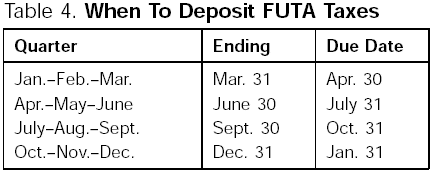
When To Deposit FUTA Taxes
Reporting FUTA tax.
Use Form 940 or 940-EZ, Employer's Annual Federal Unemployment (FUTA) Tax Return, to report this tax. The IRS will mail a
preaddressed Form 940 or 940-EZ to you if you filed a return the year before. If you do not receive Form 940 or 940-EZ, you can get the form by
calling 1-800-TAX-FORM (1-800-829-3676).
Form 940-EZ requirements.
You may be able to use Form 940-EZ instead of Form 940 if (1) you paid unemployment taxes (contributions) to only one state, (2) you paid
state unemployment taxes by the due date of Form 940 or 940-EZ, and (3) all wages that were taxable for FUTA tax purposes were also taxable for your
state's unemployment tax. For example, if you paid wages to corporate officers (these wages are subject to FUTA tax) in a state that exempts these
wages from its unemployment taxes, you cannot use Form 940-EZ.
Household employees.
If you did not report employment taxes for household employees on Form 941 or 943, report FUTA tax for these employees on Schedule H (Form
1040), Household Employment Taxes. See Pub. 926 for more information.
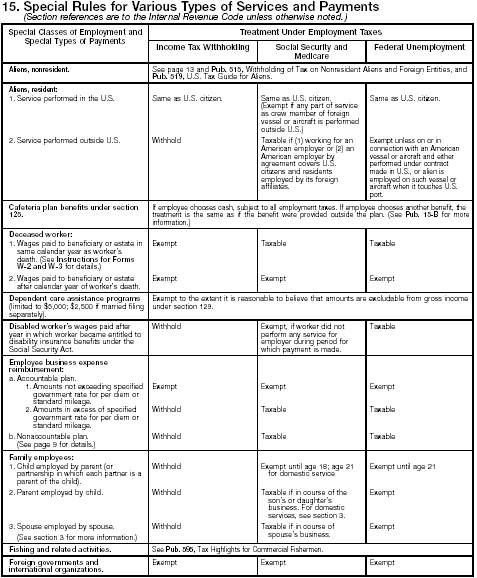
Special Rules Chart – 1
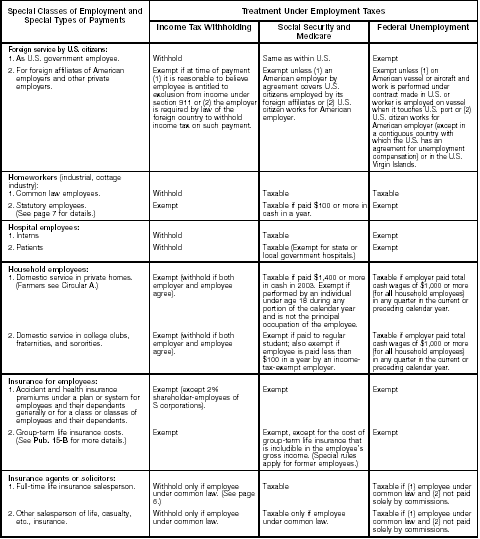
Special Rules Chart – 2
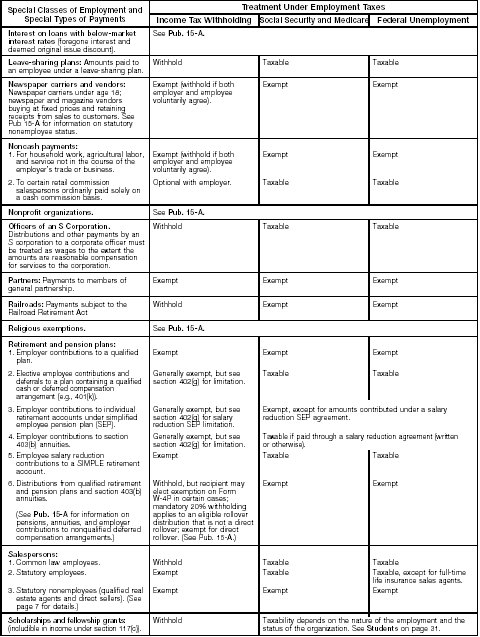
Special Rules Chart – 3
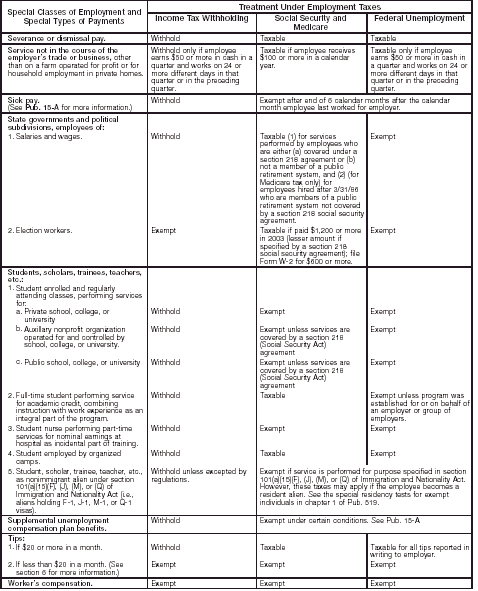
Special Rules Chart – 4
16. How To Use the Income Tax Withholding and Advance Earned Income Credit (EIC) Payment Tables
Income Tax Withholding
There are several ways to figure income tax withholding. The following methods of withholding are based on information you get from your employees
on Form W-4, Employee's Withholding Allowance Certificate. See section 9 for more information on Form W-4.
Wage Bracket Method
Under the wage bracket method, find the proper table (on pages 36-55) for your payroll period and the employee's marital status as shown on his or
her Form W-4. Then, based on the number of withholding allowances claimed on the Form W-4 and the amount of wages, find the amount of tax to withhold.
If your employee is claiming more than 10 withholding allowances, see below.
Note:
If you cannot use the wage bracket tables because wages exceed the amount shown in the last bracket of the table, use the percentage method of
withholding described below. Be sure to reduce wages by the amount of total withholding allowances in Table 5 before using the percentage method
tables (pages 34-35).
Adjusting wage bracket withholding for employees claiming more than 10 withholding allowances.
The wage bracket tables can be used if an employee claims up to 10 allowances. More than 10 allowances may be claimed because of the special
withholding allowance, additional allowances for deductions and credits, and the system itself.
To adapt the tables to more than 10 allowances:
- Multiply the number of withholding allowances over 10 by the allowance value for the payroll period. (The allowance values are in Table 5,
Percentage Method - 2002 Amount for One Withholding Allowance later.)
- Subtract the result from the employee's wages.
- On this amount, find and withhold the tax in the column for 10 allowances.
This is a voluntary method. If you use the wage bracket tables, you may continue to withhold the amount in the 10 column when your employee
has more than 10 allowances, using the method above. You can also use any other method described below.
Percentage Method
If you do not want to use the wage bracket tables on pages 36 through 55 to figure how much income tax to withhold, you can use a percentage
computation based on Table 5 and the appropriate rate table. This method works for any number of withholding allowances the employee claims and any
amount of wages.
Use these steps to figure the income tax to withhold under the percentage method:
- Multiply one withholding allowance for your payroll period (see Table 5 below) by the number of allowances the employee claims.
- Subtract that amount from the employee's wages.
- Determine the amount to withhold from the appropriate table on pages 34 and 35.
Table 5. Percentage Method - 2002 Amount for One Withholding Allowance
| Payroll Period |
One Withholding Allowance |
| Weekly |
$57.69 |
| Biweekly |
115.38 |
| Semimonthly |
125.00 |
| Monthly |
250.00 |
| Quarterly |
750.00 |
| Semiannually |
1,500.00 |
| Annually |
3,000.00 |
| Daily or miscellaneous (each day of the payroll period) |
11.54 |
Example:
An unmarried employee is paid $600 weekly. This employee has in effect a Form W-4 claiming two withholding allowances. Using the percentage method,
figure the income tax to withhold as follows:
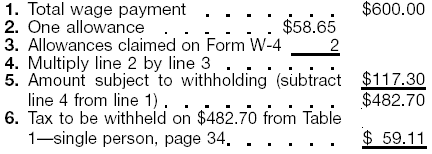
Percentage Method Example
To figure the income tax to withhold, you may reduce the last digit of the wages to zero, or figure the wages to the nearest dollar.
Annual income tax withholding.
Figure the income tax to withhold on annual wages under the Percentage Method for an annual payroll period. Then prorate the tax back to the
payroll period.
Example:
A married person claims four withholding allowances. She is paid $1,000 a week. Multiply the weekly wages by 52 weeks to figure the annual wage of
$52,000. Subtract $12,000 (the value of four withholding allowances for 2002) for a balance of $40,000. Using the table for the annual payroll period
on page 35, $4,432.50 is withheld. Divide the annual tax by 52. The weekly tax to withhold is $85.24.
Alternative Methods of Income Tax Withholding
Rather than the Percentage or Wage Bracket Methods described on page 32, you can use an alternative method to withhold income tax. Pub. 15-A,
Employer's Supplemental Tax Guide, describes these alternative methods and contains:
- Formula tables for percentage method withholding (for automated payroll systems).
- Wage bracket percentage method tables (for automated payroll systems).
- Combined income, social security, and Medicare tax withholding tables.
Some alternative methods explained in Pub. 15-A are annualized wages, average estimated wages, cumulative wages, and part-year employment.
Advance Payment Methods for the Earned Income Credit (EIC)
To figure the advance EIC payment, you may use either the Wage Bracket Method or the Percentage Method explained below. You may use other methods
for figuring advance EIC payments if the amount of the payment is about the same as it would be using tables in this booklet. See the tolerances
allowed in the chart in section 10 of Pub. 15-A. See section 10 in this booklet for an explanation of the advance payment of the EIC.
The number of withholding allowances an employee claims on Form W-4 is not used in figuring the advance EIC payment. Nor does it matter that the
employee has claimed exemption from income tax withholding on Form W-4.
Wage Bracket Method
If you use the wage bracket tables on pages 58 through 61, figure the advance EIC payment as follows.
Find the employee's gross wages before any deductions using the appropriate table. There are different tables for (a) single or head of
household (b) married without spouse filing certificate (c) married with both spouses filing certificates. Determine the amount
of the advance EIC payment shown in the appropriate table for the amount of wages paid.
Percentage Method
If you do not want to use the wage bracket tables to figure how much to include in an employee's wages for the advance EIC payment, you can use the
percentage method based on the appropriate rate table on pages 56 and 57.
Find the employee's gross wages before any deductions in the appropriate table on pages 56 and 57. There are different tables for (a)
single or head of household (b) married without spouse filing certificate (c) married with both spouses filing
certificates. Find the advance EIC payment shown in the appropriate table for the amount of wages paid.
Whole-Dollar Withholding and Paying Advance EIC (Rounding)
The income tax withholding amounts in the wage bracket tables (pages 36-55) have been rounded to whole-dollar amounts.
When employers use the percentage method (pages 34-35) or an alternative method of income tax withholding, the tax for the pay period may be
rounded to the nearest dollar.
The wage bracket tables for advance EIC payments (pages 58-61) have also been rounded to whole-dollar amounts. If you use the percentage method for
advance EIC payments (pages 56-57), the payments may be rounded to the nearest dollar.
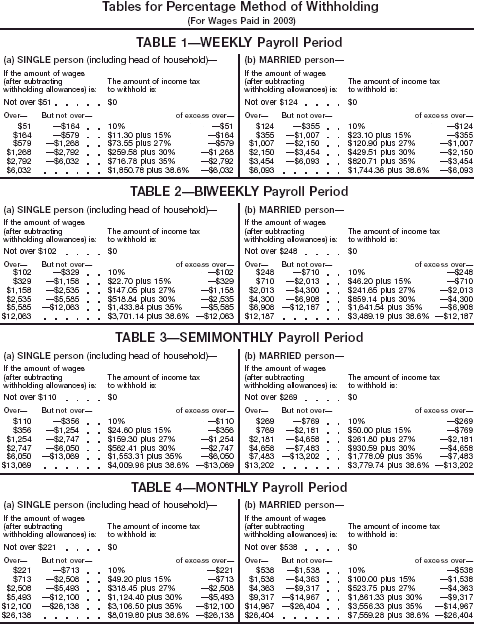
Percentage Method 1
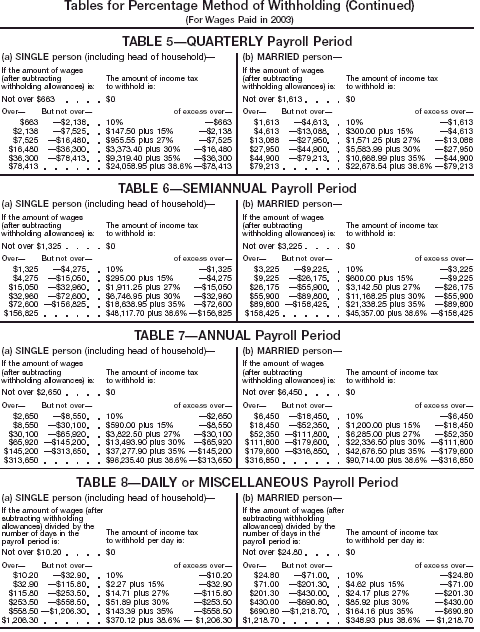
Percentage Method 2
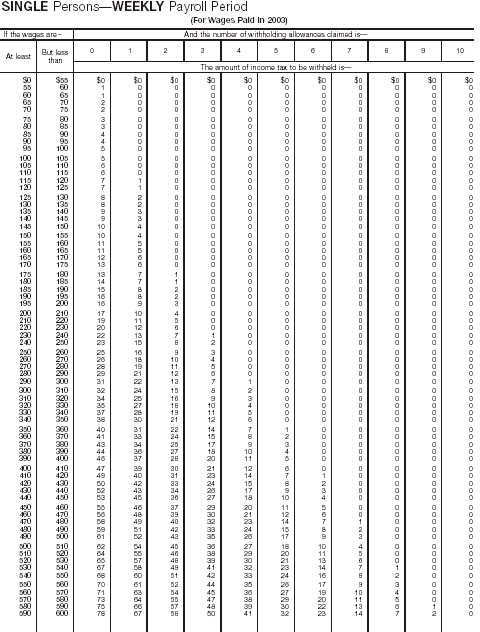
Wage Bracket 1
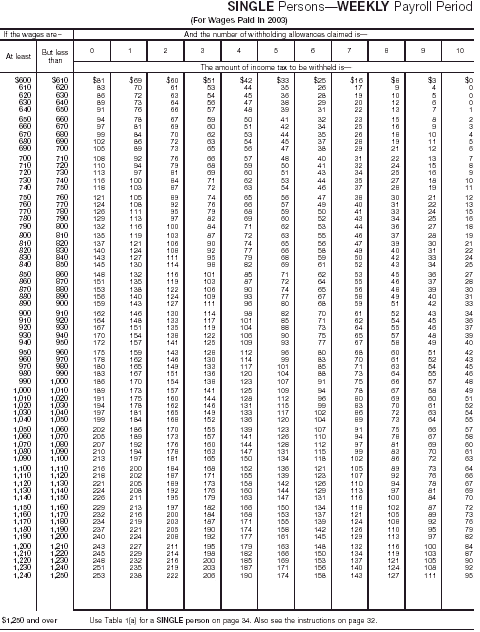
Wage Bracket 2
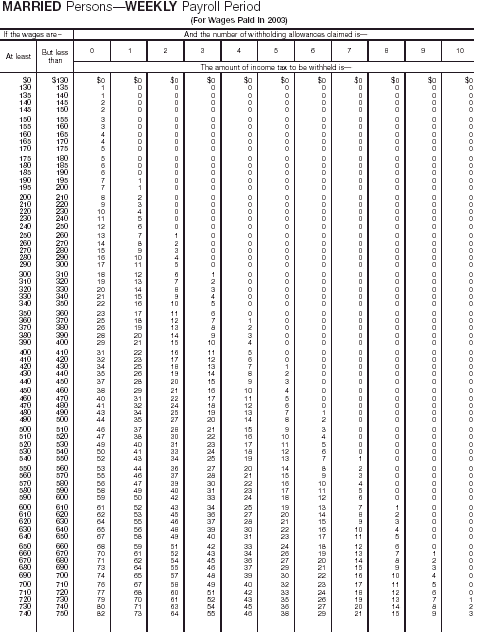
Wage Bracket 3
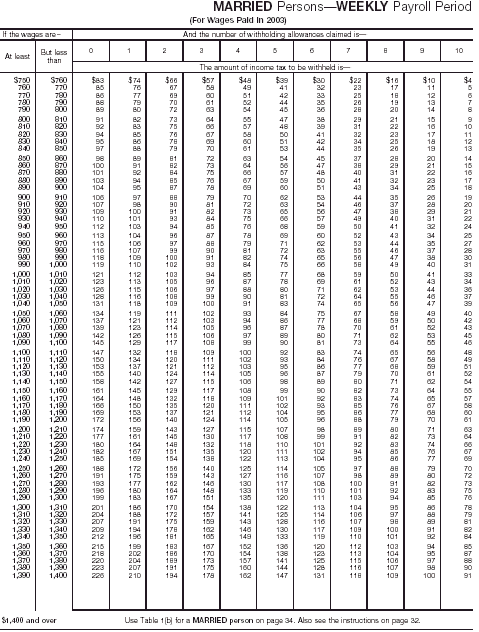
Wage Bracket 4
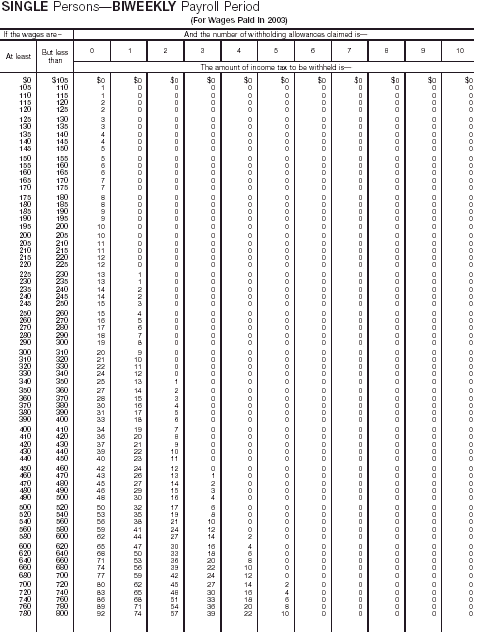
Wage Bracket 5
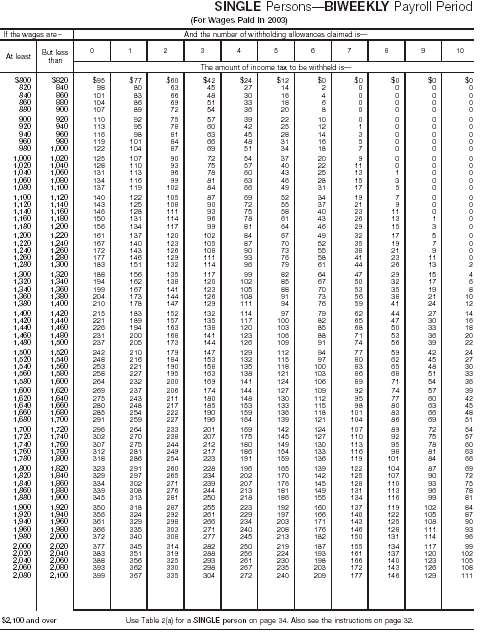
Wage Bracket 6
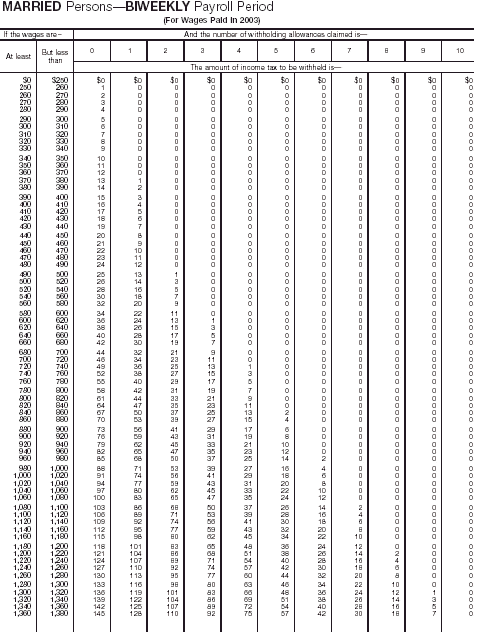
Wage Bracket 7
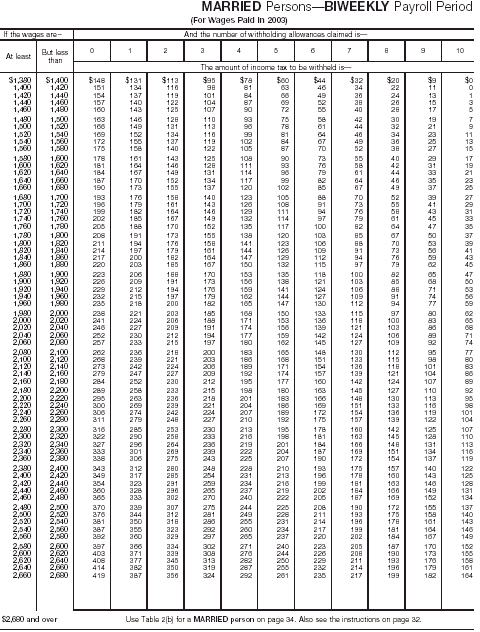
Wage Bracket 8
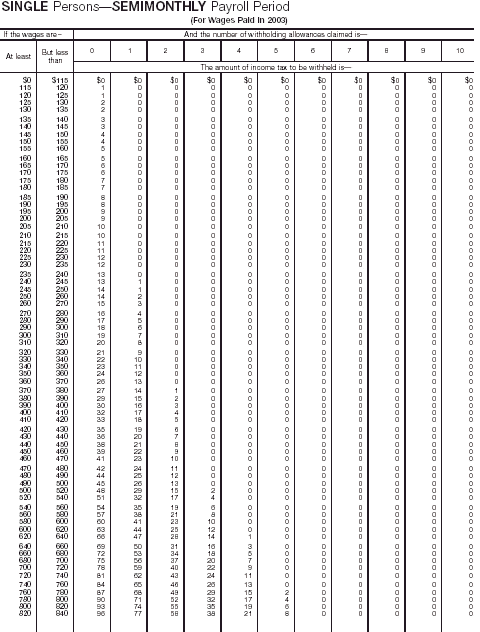
Wage Bracket 9
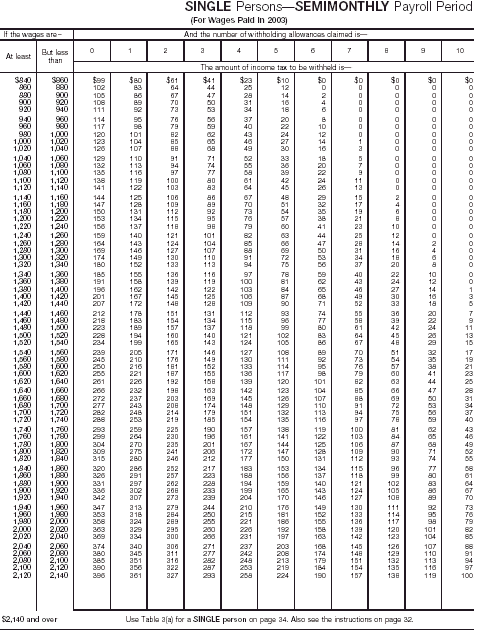
Wage Bracket 10
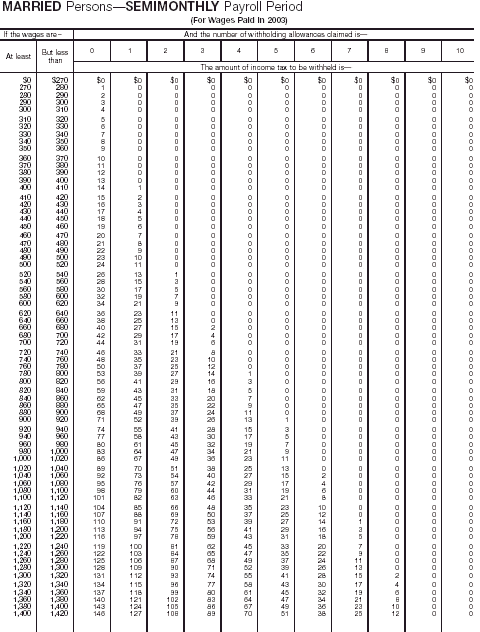
Wage Bracket 11
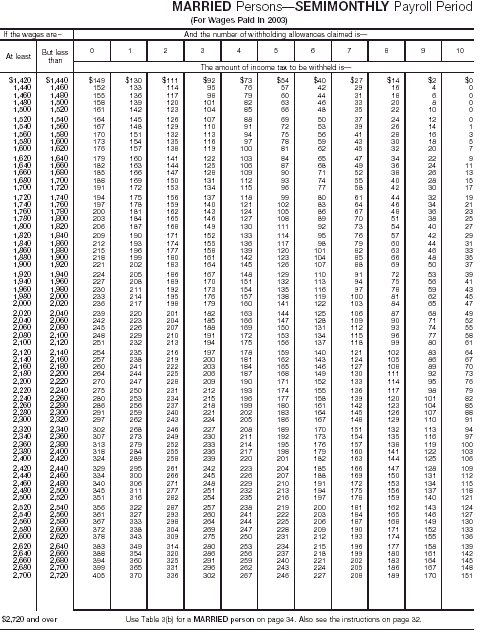
Wage Bracket 12
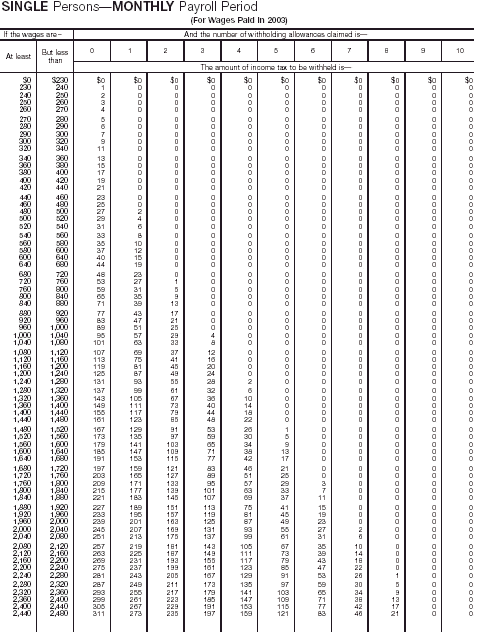
Wage Bracket 13
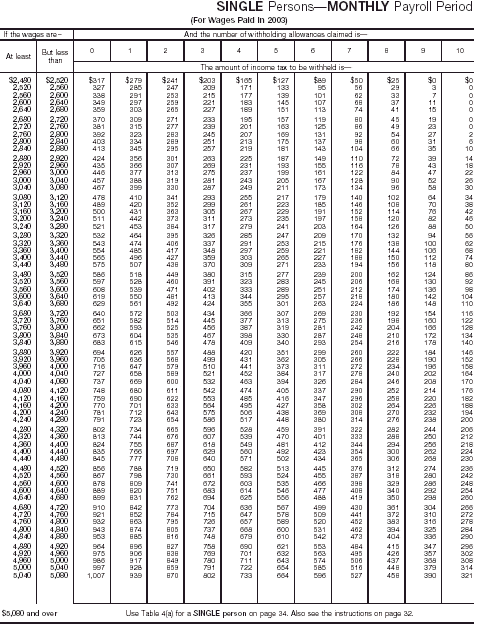
Wage Bracket 14
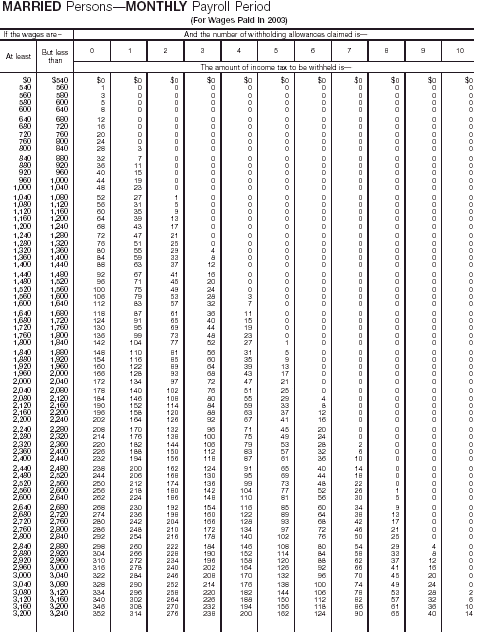
Wage Bracket 15
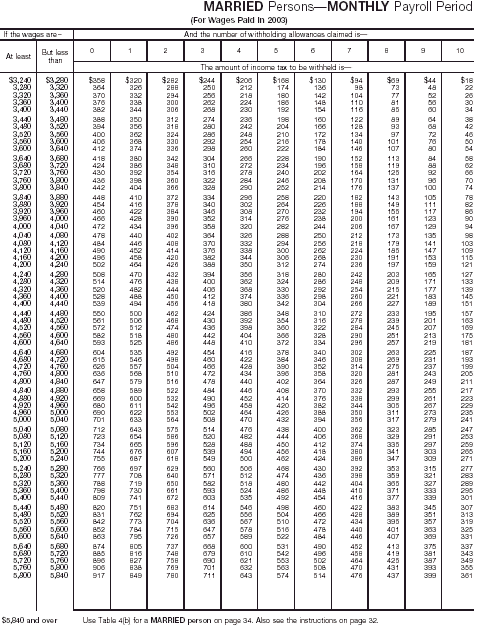
Wage Bracket 16
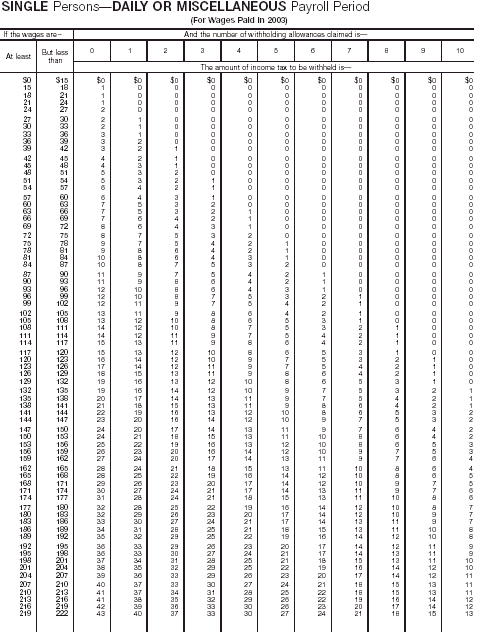
Wage Bracket 17
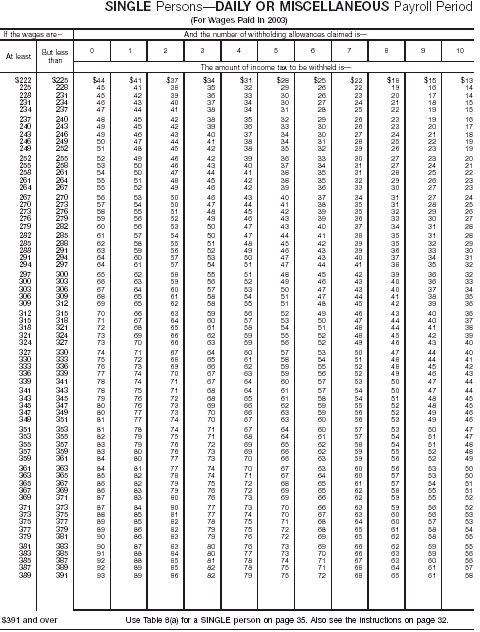
Wage Bracket18
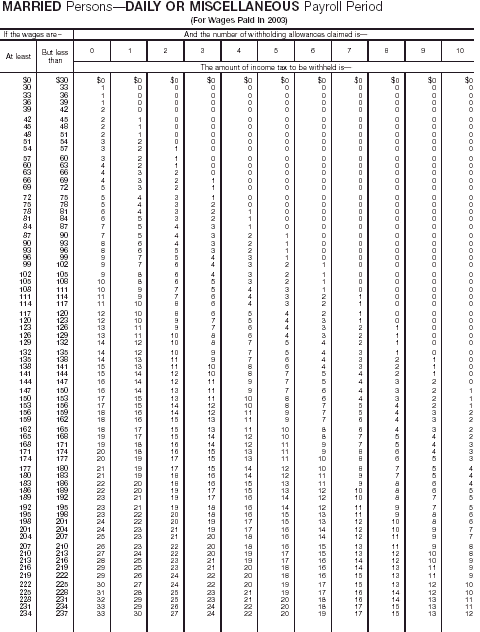
Wage Bracket 19
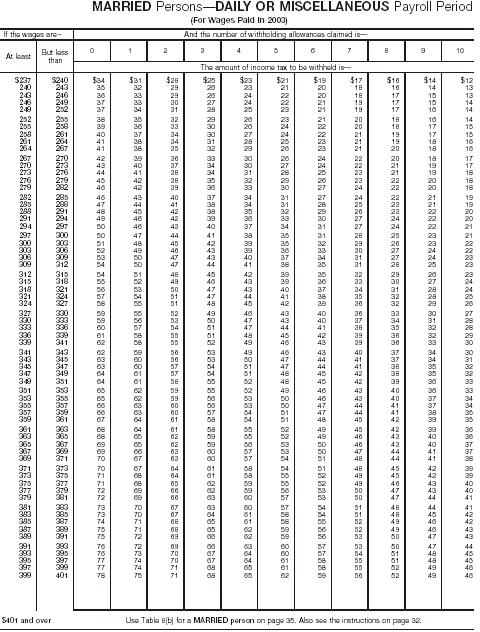
Wage Bracket 20
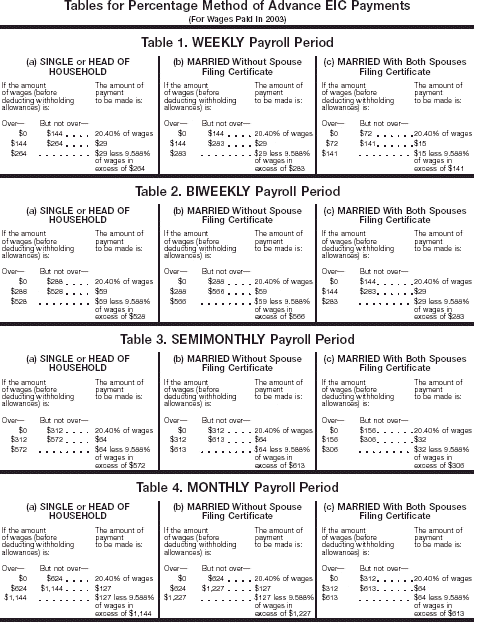
Percentage Method AEIC 1
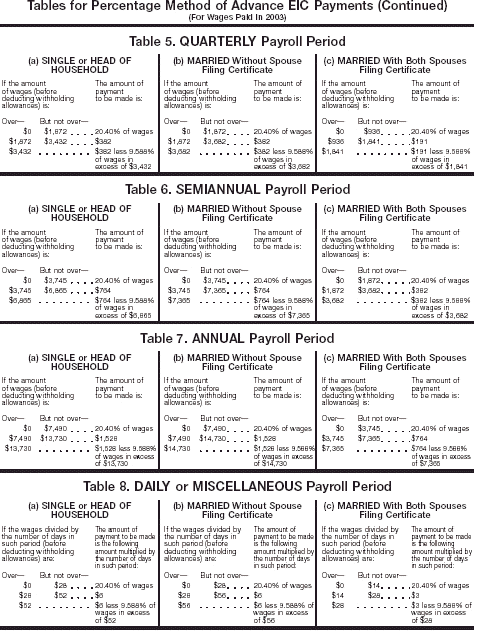
Percentage Method AEIC 2
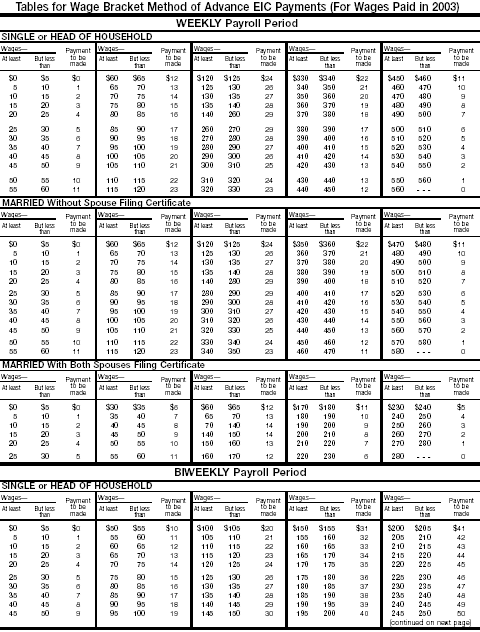
Wage Bracket AEIC 1
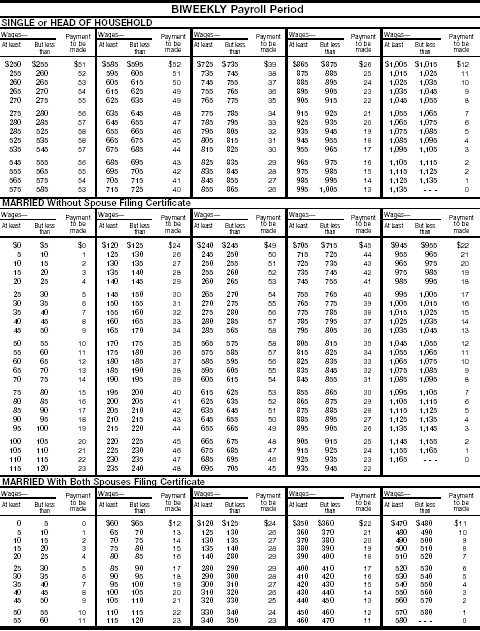
Wage Bracket AEIC 2
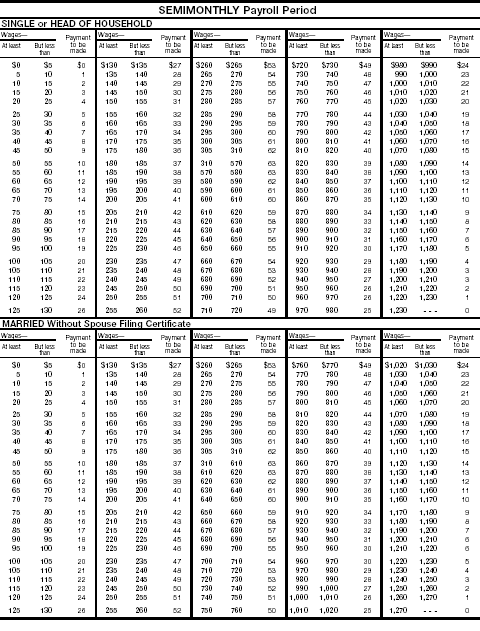
Wage Bracket AEIC 3
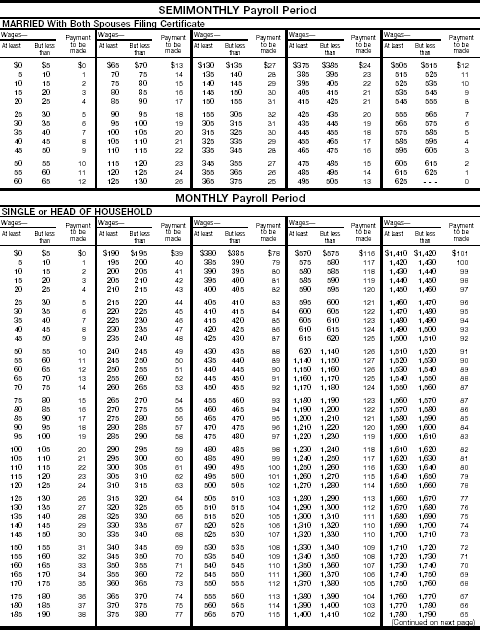
Wage Bracket AEIC 4
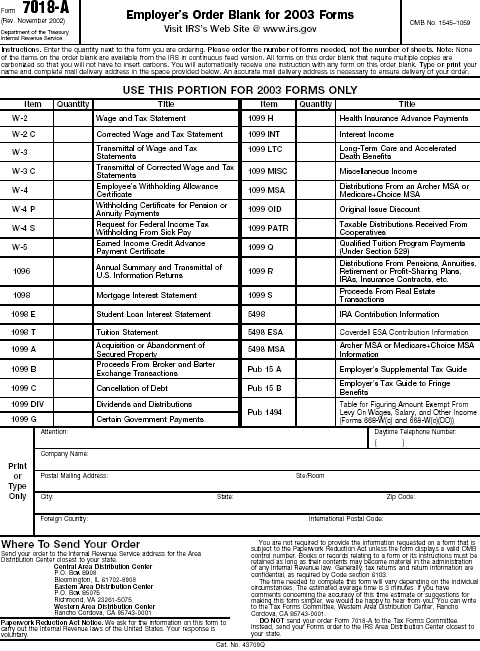
Employer's Order Blank
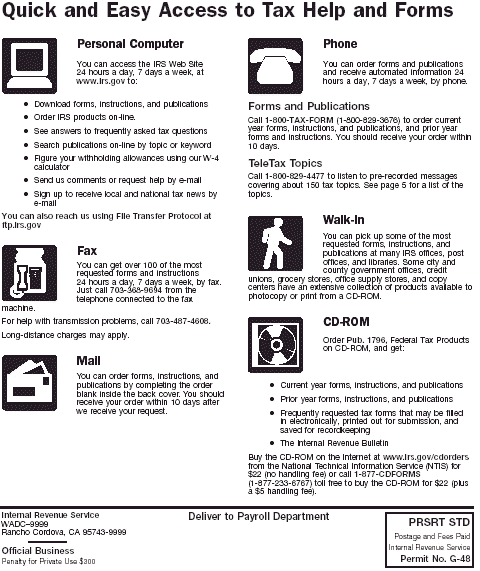
Multi-Media/Back Page
Previous | First
Publication Index | 2002 Tax Help Archives | Tax Help Archives | Home






































